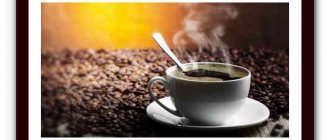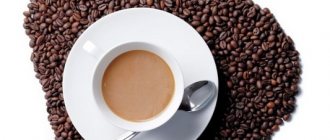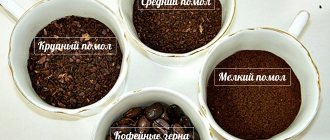Home › about Food and Dishes › Dishes › Drinks › Coffee at home: eight methods of preparation
Author
Anastasia Grishchenko
Coffee is a drink without which many cannot imagine their morning. You don’t have to go to a coffee shop to drink a cup of invigorating drink. The “Simply There” correspondent found out from barista Alena Averyanova how you can make aromatic coffee in your kitchen.
Coffee beans
When purchasing coffee beans, you need to study information about single varieties. The taste largely depends on the brand of coffee. Each trading company has its own methods of processing coffee, so the same single variety may taste slightly different.
Single-origin coffee is coffee from one plantation. If a coffee is called "Ethiopia", it means it is from Ethiopia. Sometimes the name may contain the names of plantations or the port of departure: “Ethiopia Sidamo”, “Ethiopia Harrar”, etc. You should not buy flavored varieties (“Vanilla”, “Cherry”, “Amaretto” and others). First, these flavors are not always individual. Secondly, why spoil the taste of natural coffee with additives? Thirdly, it is unknown what taste the drink will have in the end.
There are several types of roasting coffee beans:
- Light, or Scandinavian, roast: the beans have a light brown hue and a sour taste.
- The medium degree of roasting, Viennese, has a darker color and a fuller development of aroma.
- Strong roast, French, is perhaps the most popular in America and Europe. The grains are dark and oily, and the drink has a slight bitterness.
- The strongest degree of roasting is Italian. The beans are roasted at very high temperatures until they are almost black.
To make coffee at home, it is better to choose medium roast beans. When coffee is dark roasted, the taste becomes bitter, it is not always possible to get a pleasant aftertaste, most of the beneficial substances and essential oils are burned. You will end up drinking a bitter drink. Often coffee is roasted heavily to hide some negative aspects. It is believed that high-quality grain will never be dark roasted.
An important aspect is the grinding of coffee. For each method of preparing coffee, the grind is selected based on the type of drink you want to get. Extraction depends on the fineness of grinding. Extraction is the interaction of coffee with water. The finer the grind, the more flavor substances will be released from the grain. But at the same time, fine grinding is only suitable for Turks. If you make finely ground coffee in a French press, it will simply clog and it will be difficult to get the drink itself.
There are several universal rules to remember when making coffee:
- Coffee should be poured into heated cups. Before making coffee, pour hot water into the cups, let them warm up, and when you are ready to pour the coffee, pour the water out of the cups and wipe with a clean, dry cloth.
- It is not recommended to use espresso blends, only pure single-origin varieties. Home methods are designed not to invent new tastes, but to reveal existing ones. But the choice of a specific monovarietal is purely a matter of your taste.
- Any coffee you make at home doesn't like three things: wet dishes, cold dishes and boiled water.
How to make homemade coffee tastier: life hacks and useful barista tips
Ground grains, water and a little time. It would seem that what could be easier than brewing a cup of coffee at home? But each cooking method has its own characteristics and secrets. Our expert barista Vyacheslav Poschishchailo talks about how and what to make truly delicious coffee at home.

Turk
The most popular method of brewing coffee at home in Russia is a metal or ceramic cezve. It involves many original recipes, with the addition of spices, candied fruits, honey, garlic, and everything the home barista desires.
Classic Turkish coffee recipe: for 10 g of finely ground coffee you need 100 g of water. Cook over low heat until foam begins to rise, never bringing to a boil.
In order not to “shock” the finished coffee by pouring from a hot cezve into a cold cup, rinse the cup with hot water in advance. This way the coffee will fully retain its aroma.

French press
A small glass teapot with a press that holds the coffee grounds at the bottom was invented in the 19th century. When brewing coffee in a French press, more substances are extracted than any other method.
In addition to caffeine, the infusion contains more essential oils and antioxidants.
Classic recipe: pour coarsely ground coffee into a French press, add hot water and let it brew for 4 minutes, then lower the piston to the very bottom and pour coffee into a cup.
The brewing water temperature should be 92-95 degrees, and the amount of ground coffee should be 2-2.5 tablespoons per 1 cup with a capacity of 150-200 ml. Then the coffee will be rich and strong, but will not start to taste bitter.
Geyser coffee maker
Moka is based on the principle of using steam pressure from boiling water in the bottom section of the device, which passes through the compartment with ground coffee, thereby brewing it. The coffee is close to espresso in taste and quite strong.
For such a coffee maker, it is not necessary to calculate the proportions of water and coffee: inside the lower compartment there is a mark for water, and the compartment with coffee must be filled completely.
It is recommended to pour hot water into the geyser coffee maker. This way the coffee will not be over-extracted and will not become bitter. You can “forcibly” stop the extraction of already prepared coffee by placing the moka with the finished coffee on a damp, cool towel.
Coffee beans LavAzza “Qualita Oro”, 500 g
752 rub.
Lavazza “Qualita Oro” coffee beans, 250 g 351 rub.
Bean coffee Bushido “Red Katana”, 1000 g 1921 rub.
Coffee beans Lavazza “Qualita Oro”, 1000 g 1550 rub.
View all bean coffee
Drip coffee maker
Inexpensive electric coffee maker operating on the filtration principle. Boiling water from the tank rises through the tube into the compartment with ground coffee, seeps through it under natural pressure and ends up in the coffee pot as a finished drink. This coffee maker is an ideal solution for lovers of weak Americano, but for those who prefer rich espresso or oriental coffee, it is not suitable.
You can add a little salt and sugar to improve the taste.
And it is very important to immediately make the right choice of equipment: in the case of a drip coffee maker, 50% of the result depends on how good it is, and the remaining 50% on the quality of the coffee.
Vacuum siphon or gabet (for advanced amateurs)
This is an unusual and interesting brewing device that allows you to brew coffee and entertain guests at the same time.
Under the action of an alcohol or gas burner, the water is heated and the coffee placed in the upper container is brewed with rising steam. Just as we extinguish the flame, gravity forces the brewed coffee to flow spectacularly through the filter into the lower vessel. The resulting drink retains the delicate natural taste of coffee.

The siphon gives room for experimentation. To lightly flavor coffee, for example, you can add a little cherry or apple juice to the water.
In addition, the siphon can be used not only for coffee, but also for making tea - pu-erh brewed in it is especially good.
Bonus: coffee mug recipe
If you don't have any time, you can brew freshly ground coffee in a regular mug. Below is my favorite morning recipe from Ethiopia, washed and medium roasted:
- grind 2 tablespoons of coffee (medium grind) into a 220 ml steel mug;
- I add salt on the tip of a teaspoon (this amount doesn’t taste like salt at all, but it gives it a unique consistency and definitely helps the aroma to reveal itself brighter);
- I add ¼ teaspoon of sugar (this will not make the coffee sweet, but the sugar will enhance the perception of aroma and taste);
- pour hot water, stirring, cover with a lid and a towel, let it brew for 3-4 minutes;
- I remove the lid and gently stir the foam that has formed on top so that large particles of coffee settle to the bottom.
Carefully pour the coffee into a cup of suitable volume, leaving all the grounds at the bottom of the first mug. I add 2 teaspoons of 10% cream.
Turk
When preparing Turkish coffee, cold water is used. Initially, it was believed that Turkish coffee was prepared only on sand, but since we do not have the opportunity to cook in such conditions, we can use ordinary fire. There's nothing wrong with that, it doesn't change the taste. Take ordinary cold purified water, very finely ground coffee, 5-6 grams per serving. If you want the taste to be more intense – 8-9 grams per 100 ml of water. 100 ml is the average amount of coffee in your cup, prepared in a Turk. If you prepare coffee correctly, there will definitely be a thick sediment, similar to a viscous mass. The first thing you need to do when preparing coffee in a Turk is to first pour cold water over the Turk. Next, add a portion of coffee, sugar, and spices as desired into cold water. You should not let the coffee boil - as soon as a cap of foam begins to rise, you must immediately remove the Turk from the heat. If the coffee boils, the drink is spoiled and needs to be thrown out. It is served with foam. It is advisable to use small porcelain cups no larger than 100 ml. Approximate cooking time is 4-5 minutes, depending on the heat. The cost of Turks is on average from 400 to 3000 rubles. But if you wish, you can also find old, exclusive pieces for a higher price.
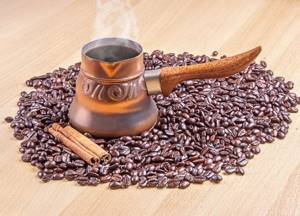
Making coffee in Turkish
Choosing a Turk
Turka has been known since the times of the Ottoman Empire, and, in fact, the name of this dish speaks of its origin. In its historical homeland it is called cezve, and both names have taken root in the Russian language.
Today, Turks make from a variety of materials: copper, aluminum, stainless steel, brass and even ceramics. There are both small Turks for a 100 ml cup, and large ones for a solid mug.
Among coffee lovers, preference is given to copper small Turks.
Copper heats up evenly, and the small volume allows you to maximize the flavor of the grain.
Aluminum cookware heats up quickly, but in principle it is not advisable to use it for cooking any food, since this material reacts with food when heated. The stainless steel heats up unevenly, which is why a hot spot of the highest temperature appears in the center of the cookware, and the coffee begins to boil, although the temperature at the edges has not yet reached the desired level.
Ceramics and clay also warm up, but these materials continue to give off heat even when you have already removed the dishes from the stove: the foam will continue to rise, and there is a risk that you will flood the table or stove. Due to the porous structure, clay cezves absorb odors well, so over time the taste of coffee will only get better, but you can only use it for preparing one type.
If you have an induction cooker, then it makes no sense to take a ceramic pot: it simply won’t heat up. If you buy a copper one, please note that there should be special inserts in its bottom, onto which induction will be induced.
The most correct form of a Turk is a traditional conical one with a funnel-shaped bell. The cone will prevent the thickness from rising to the top, and the bell will prevent the foam from rising too quickly, which is especially important for those who have not had any experience using this cookware before. The handle can be any length, but the longer it is, the more convenient it will be for you to remove the Turk from the heat.
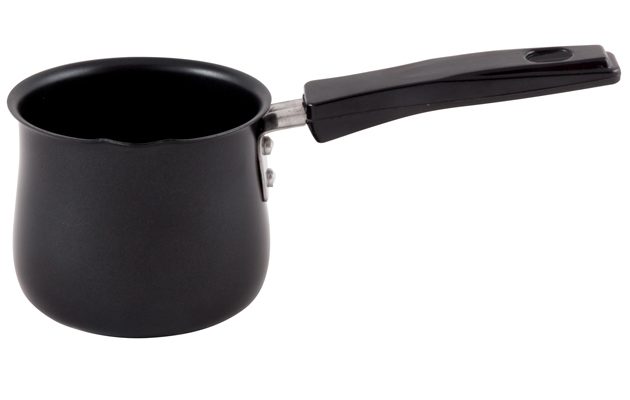
Cooking in Turk
Rinse the Turk, add 1 teaspoon of finely ground coffee and add 75 ml of cold water. Add sugar or a few grains of salt before putting the Turk on low heat. These components somewhat slow down the boiling process and make the foam denser.
Place on the fire, heat, but do not bring to a boil. Your main task now is not to be distracted and wait for the moment when the foam rises. Remember the funnel-shaped bell? It will increase your chances of capturing this moment and not letting the coffee flood the stove.
Remove the Turk from the heat, let the foam settle and put it back on the fire. Three times the foam should rise and three times you should lower it. The process is clearly shown in this video.
Using a Turk is not an easy task and requires attention and certain skills. But this particular method of brewing coffee has many followers, since it requires a minimum of equipment: only the right dishes and a stove.
French press
It is considered the most popular and easiest method of brewing coffee at home. The French press is a glass flask installed in a glass holder. A piston is inserted into it, before cooking it is pulled out, the flask is heated with hot water, coarsely ground coffee is poured in (8-9 grams per 100 ml) and filled with hot water from 88 to 94 degrees. Coffee should be ground just before brewing, and the grind should be coarse to prevent particles from passing through the French press filter. Water must be filled to a level just below the fully raised piston. Stir the coffee quickly to improve the extraction process. Coffee releases carbon dioxide, which creates a fluffy cap on the surface. If this does not happen, then you got stale coffee. Now you need to cover the coffee pot with a lid with the piston raised up. After 4-5 minutes the piston needs to be lowered. The advantage of a French press is that the strength of the drink can be adjusted independently: the longer you brew, the stronger the coffee will be (the more contact of water with the coffee bean, the more caffeine there will be in the drink). The downside of this method is the presence of coffee particles in the cup, and also the fact that the drink tends to cool quickly in a French press if you leave it to brew longer. The cost of a French press depends on the quality of the material used and the volume - you can find a small teapot for 200 rubles and a large one for 2000.
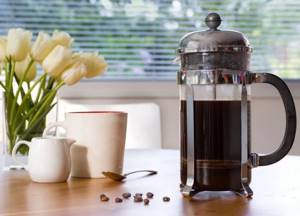
The Right Ingredients
Quality coffee
Arabica and Robusta are the most popular varieties of coffee. Precisely varieties, since these coffee trees are also divided into subspecies, so two different packages with the attractive inscription “100 percent Arabica” will have different tastes.
Arabica has a more noble taste with a slight sourness, Robusta is coarser, astringent and strong. Robusta is never used in its pure form, only as an admixture to Arabica. It produces excellent dense crema in espresso, which is why baristas love it.
The taste of coffee depends on many factors: place of growth, degree of roasting, combination of varieties (if it is a mixture), storage conditions.
Proper coffee is sold in opaque packaging with a degassing valve, which removes carbon dioxide outside and prevents oxygen from penetrating inside. After roasting, coffee releases several liters of carbon dioxide during the day. If you see a package in a store without such a valve, it means that the coffee was not packaged immediately after roasting, but was left to degas for some time and has significantly lost its taste. Essential oils partially evaporate during degassing.
Look at the roast date. The closer it is to today's date, the better. Ideally, no later than two weeks, but this is difficult to achieve even for stores specializing in selling only coffee and tea.
Take coffee beans. There are several reasons for this.
- Self-ground coffee eliminates the presence of foreign impurities in the cup. It is easier for unscrupulous producers to mix cheaper varieties of robusta and even chicory, malt, barley, and rye into ground coffee. It’s better to grind it yourself, even in the simplest coffee grinder.
- The basis of the taste of coffee is essential oils. As we now know, oxygen is the main enemy of proper taste. Grinding before immediate brewing will maximize the aroma of the beans.
- You have more opportunities to experiment. Coffee for espresso machines requires a medium grind, for a French press - coarse, and for Turkish coffee it should resemble flour.
- You will be able to evaluate the shape of the grain itself, make sure that the grains are the same size, matte and intact. The uniformity of the grains eliminates the admixture of cheaper robusta. The shine indicates that the grain has been stale and has already begun to release essential oils. The splinters will produce a bitter taste as they are roasted more intensely than the whole grain. Of course, you can understand all this only when you open the package and draw conclusions about the manufacturer for the future.
Ideally, spring water, but you can get by with filtered water. The main thing is not to take water directly from the tap and do not use already boiled water.
Spices
Some coffee lovers add a little salt when preparing, which helps to better reveal the taste and aroma of coffee and reduce bitterness. If you decide to use salt, then use the most common table salt, coarsely ground. There is a risk of over-salting with the extra variety, and iodized salt will give an unpleasant aftertaste.
From theory we move on to practice - brewing coffee.
Aeropress
One of the simplest methods of making coffee after the French press. It was invented relatively recently - in 2009. Very easy to use, small, you can even take it with you on a hike. Its operating principle is the piston method. This is a cylinder into which another cylinder, a paper filter and a perforated plug are inserted. Next, pour in 8-18 grams of finely ground coffee, add water at 88-94 degrees, and infuse the coffee. The advantage of the method: a pure drink without particles. It is important that the coffee is freshly ground and the dishes are hot. Preparing coffee in an AeroPress will take you about 3 minutes, its average cost is from 2,000 rubles.
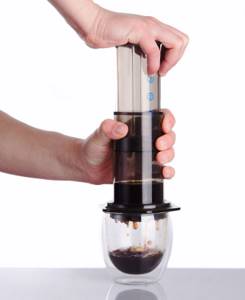
Geyser coffee maker (Moka Express)
Moka is widely used in Europe, especially in its homeland, Italy, where it is a national symbol. The original Moka is made of aluminum with bakelite handles. The principle of operation is as follows: steam reaches high pressure and gradually displaces boiling water through a funnel and filter containing ground coffee. The water passes through the coffee powder and enters the upper reservoir, where the finished coffee is collected. The required amount of drinking water must be poured into the lower reservoir and covered with a metal filter. Then pour medium-ground coffee into the filter funnel at the rate of 9-12 grams per cup of coffee. Then screw on the top and put on low heat. After the water boils, the finished drink will begin to flow into the upper reservoir; after the end of the coffee flow, remove the coffee maker from the heat. Cooking time – 5-8 minutes. The price range of geyser coffee makers is from 700 to 5000 rubles.

White chocolate latte
White chocolate latte is a recipe that will please all lovers of sweets. Here's a simple way to sweeten your life. With white chocolate, the latte turns out even tastier and more interesting.
Ingredients:
Ground coffee - 2.5 tbsp. l. Water - 320 ml Milk - 700 ml White chocolate - 120 g
Cooking method:
Pour coffee into a French press and add hot water. Cover with a lid and leave to steep for 3-4 minutes.
Pour milk into a saucepan and place over medium heat. Bring to a boil and add chopped chocolate.
Stir for 2 minutes until the chocolate has melted. Then beat until thick foam forms and remove from heat.
Pour coffee into tall glasses. Use a spoon to add foam from the milk on top and pour in a small amount of the milk itself. Serve immediately.

Drip coffee maker (filter coffee maker)
It is especially popular in offices. Cold water is poured into a special glass container; the average volume of the tank is about 1 liter. Medium ground coffee (8-9 grams per 100 ml) is poured into a cone filter. The lid closes, the coffee maker turns on - the water heats up, rises through a special tube, falls into the filter with coffee, and brews it. Then the finished drink drips into the coffee pot. When the water in the reservoir runs out, the coffee maker automatically switches to the drink heating mode. There is a heating pad under the coffee pot, which allows the coffee in the pot to cool down very slowly. The average price of a drip home (or office coffee maker) is from 1000 to 5000 rubles. Depending on the type of coffee maker and the volume of water, preparing coffee will take on average from 5 to 15 minutes.
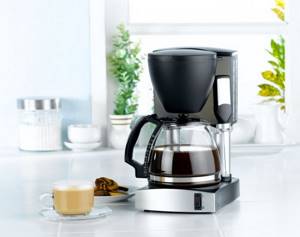
Chemex
This method of making coffee was invented in 1941 by the Americans. The Chemex was popular more because of its design: a chemical flask with a large funnel. Usually, at the narrowest point of the Chemex, either a wooden or rubber nozzle is made to make it convenient to grip. The Chemex must be made of thick heat-resistant glass so that nothing cracks upon contact with hot water. Before you start preparing the drink, you need to make sure that the water is between 88 and 94°C. This temperature is necessary to ensure that the coffee does not burn. A special paper filter is taken, placed in a heated flask, doused with hot water - it is necessary that the filter be moistened so that it can stick to the flask and air does not penetrate into it. Then the water is drained, since it has already cooled down, and coffee does not like cold water. Medium grind coffee is poured on top - an average of 25 grams of coffee is used per 360 ml. Next, water is poured in - it needs to be poured slowly from the edge to the center. You must first pour 30-60 ml of water and wait 30-60 seconds for the coffee to open and come into contact with oxygen, and then slowly pour in the rest of the water in a thin stream. If you pour coffee in a thick stream at once, the water will be distributed unevenly throughout the coffee and it will not brew properly. It is better not to use bitter varieties for Chemex; this is one of the methods where the drink turns out to be sweetish. You need to select grains based on your taste preferences. The coffee takes about 4 minutes to prepare. The issue price is from 2000 to 6000 rubles.
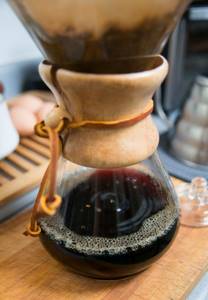
Purover
A method similar to the Chemex brewing method. The difference is that when a filter is inserted into a Chemex, it must fit snugly into the flask, whereas a pour-over has small raised grooves in the funnel into which the filter is inserted. When the filter is inserted, you need to pour water on top and make sure that it fits only along the grooves and that there is oxygen access inside. A pourover is a regular funnel into which a filter is inserted. You can put it in a cup or a teapot at once - wherever is convenient for you. Add 8-9 grams of medium-ground coffee per 100 grams of water. Another difference between a pour-over and a Chemex is that it is smaller and more compact, so you can put it anywhere and take it with you. In 4-5 minutes your coffee is ready. The price of a pourover is up to 2000 rubles.
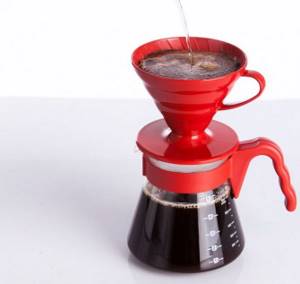
Step-by-step recipe - or how to make instant coffee without a Turk using a strainer:
- First, let's voice the necessary proportions. For 2 tablespoons of ground coffee you need to take 250 ml of hot water (this way you can brew 2 servings of strong espresso). If you prefer to brew concentrated Americano, 1 tablespoon of coffee beans will be enough
- Bring water to a boil in a kettle or saucepan
- Pour ground coffee into a cup and fill it with very hot water (after boiling, the water should sit for about 10 seconds so that the bubbles settle - and only then go into the cup)
- Now leave the drink for three to four minutes to steep. It is not necessary to cover with a lid. After the specified time has passed, stir the espresso and leave for another couple of minutes*
*The specified extraction time is valid for medium-dark and dark roasted beans (for example, Viennese or French). If you prefer a light roast, increase the extraction time by a couple more minutes. Although, it should be noted that light roasting for espresso is not the most suitable option: in this case, the taste may not be as rich and invigorating as its traditional recipe suggests.
After steeping, the coffee must be strained, although in some countries they prefer to drink it with grounds. Take another cup, after rinsing it with boiling water, and pour the brewed espresso into it through a fine strainer.
To avoid straining, you can use a special disposable filter for ground coffee. Tie or roll the filter tightly, creating the equivalent of a tea bag. Keep the proportions the same as in the previous recipe: 2 tablespoons of ground coffee beans per 250 ml of water (1 glass). After 5 minutes, remove the filter. Add cream, sugar or other ingredients to taste.
What gourmets from different countries add to coffee:
- Egg yolk and condensed milk – in Vietnam
- Sesame, black pepper and nutmeg – in Morocco
- Guinea pepper grains and ginger – in Senegal
- Rum and thick whipped cream foam - in Germany
- Garlic and honey – in Turkey
- Orange juice and rum – in Jamaica
As you can see, there are a great many exotic recipes. To feel the atmosphere of a coffee ceremony in another country, just brew coffee in a cup in a few minutes and add the ingredient corresponding to the recipe. Don’t be afraid to discover original tastes – and enjoy your coffee in the warmest company!
Video on the topic:
Siphon
The most spectacular cooking method. The siphon is very similar to a chemist's apparatus for laboratory work. A tripod and flask are installed, a water container is placed on the flask, an alcohol lamp is placed underneath, water is poured into the flask from below, a paper filter is installed on top, and coffee is poured into it. The alcohol lamp is set on fire, and it begins to heat the flask. The water evaporates, penetrates the upper filter, the coffee begins to get wet and then gradually flows down into the same flask where the water was. The siphon was often installed in bars and cooked right at the guest’s table. Coffee is prepared in a siphon for about 5 minutes. Like the Chemex, 360 ml requires 25 grams of medium-ground coffee.
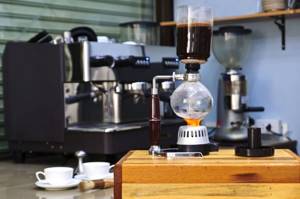
If you have certain equipment at home, you can prepare espresso. Nowadays you can buy home coffee machines; they even came up with manual and pocket espresso machines. They run on gas cartridges.
How about a cup of instant coffee?
Instant coffee contains no more than 15% coffee itself. The rest is flavoring additives, preservatives, dyes, oxidizing agents, etc. There is absolutely nothing healthy in this coffee, but rather the opposite. Instant coffee is often the cause of stomach ulcers, gastritis and cellulite. Instant coffee contains a very harmful substance – benzopyrene resin. This resin is an oxidizing agent and it has a strong effect on the body.
As for drinking natural coffee, in moderate quantities it does not harm, but benefits a healthy person. The only contraindication is high blood pressure. A harmless amount of coffee for the body is a cup or two a day.


